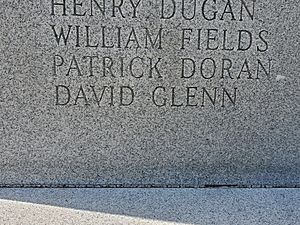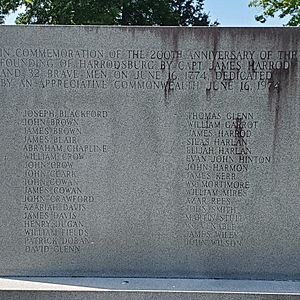David Glenn (pioneer) facts for kids
Quick facts for kids
David Glenn
|
|
|---|---|

David Glenn's name listed on the Harrodsburg Memorial
|
|
| Born | 1753 |
| Died | 1820 (aged 67) |
| Occupation | hunter, soldier, pioneer, surveyor, frontiersman, scout, longhunter |
| Military career | |
| Allegiance | |
| Branch | |
| Service | 1774–1783 (9 years) |
| Wars | Dunmore's War Clark's Illinois Campaigns American Revolution American Indian Wars |
David Glenn was born in 1753. He was probably born in Pennsylvania or Virginia. His family had Irish roots. He was an early settler in Kentucky. In 1774, he helped James Harrod start Harrodstown. His older brother, Thomas, was also with them. Harrodsburg is known as Kentucky's oldest permanent settlement. It was settled almost a year before Boonesborough.
During the American Revolutionary War, David Glenn served as a hunter and soldier. He worked for General George Rogers Clark. He joined Clark on important trips to Kaskaskia and Vincennes. These trips were part of Clark's Illinois Campaigns in 1778-79. David Glenn helped get food and supplies for Harrodsburg. He had a small cabin about 50 miles south of the fort. This cabin was used to store meat and other supplies. This area was later named Glennsville, and today it is known as Glens Fork. It was a busy town until the American Civil War.
David Glenn was a brave frontiersman. He had many stories of escaping from Native American tribes. These included the Wyandot, Mingo, Shawnee, and Delaware tribes. Later, he moved west to Yellow Banks, which is now Owensboro. He helped create Ohio County. He served as a Trustee for Hartford Academy. He was also a Justice of the Peace. In 1815, Daviess County was formed from Ohio County. David Glenn was chosen as one of its commissioners. He died in 1820 at his home.
Exploring Kentucky with James Harrod
After the Seven Years' War, the British government promised land to soldiers. About 200,000 acres in Kentucky and West Virginia were set aside. In 1774, Lord Dunmore ordered people to survey these lands. Surveyors like James Harrod, Thomas Bullitt, and the McAfee brothers led groups.
Harrod's group left Fort Redstone in May. This fort was south of Fort Pitt. They traveled down the Monongahela and Ohio Rivers. At Grave Creek, near Moundsville, 32 men joined Harrod. David and Thomas Glenn were among them. They went down the Kentucky River to the spot where Harrodsburg is today. They started planning the town on June 16.
There was a lot of tension between settlers and the Shawnee people. After some conflicts, war was about to begin. Lord Dunmore sent two skilled frontiersmen to warn the surveyors. These men were Daniel Boone and Michael Stoner. They traveled 800 miles in just 64 days. Boone arrived at Harrodstown and built a cabin. Then he continued to warn other surveyors.
Harrod's group stayed at Fort Harrod until July 10. One of their men was killed. They then left and traveled through the Cumberland Gap. They went to the Holston Valley. There, they joined the Fincastle County Battalion. David and Thomas Glenn joined Captain Harrod's company. This company was part of Colonel Christian's group. They guarded supplies while other groups went to battle. Christian's group moved quickly. They arrived near the battle site on October 8. On October 10, they got a message to hurry. They arrived at Point Pleasant just after the battle ended.
David Glenn in the Revolutionary War
In the early part of the war, David Glenn explored Kentucky. He planted corn and made improvements. In January 1777, he helped get gunpowder for settlers. Colonel John Todd had tried and failed. Harrod's small group, including David Glenn, got the powder. They returned to Harrodsburg with the help of Simon Kenton. They used a hidden path to avoid Native American groups. This powder was very important. Without it, the settlers would have been defenseless.
Glenn was a very good hunter. He was in charge of finding food for Harrodsburg's 200 people. He did this for almost two years. He and his hunting partner, William Stewart, had a cabin. It was about 50 miles south of Harrod's Station. They used it to store meat and supplies. They spent the winter of 1777-78 there. They made many trips to stock the fort. This area later became Glens Fork. David Glenn was listed twice in the Harrodsburg census. Once as "David Glenn" and once as "Glenn and Stuart."
By summer 1778, David Glenn joined General Clark's campaigns. These were in the Illinois Territory. He was part of Captain John Montgomery's company. He was one of 175 men who captured Kaskaskia on July 4, 1778. He was also one of 170 volunteers who took back Vincennes in February 1779. Glenn stayed with Clark's Illinois regiment until spring 1780.
In 1780, David Glenn explored more of Kentucky. He was with William Stewart. They explored around Bardstown. He stayed near Harrodsburg and was still active in the war. In 1781, David Glenn avenged a friend. He chased a Native American for almost a mile and defeated him.
After the Battle of Blue Licks in 1782, General Clark called for volunteers. He wanted to invade Shawnee territory. About 1,100 mounted riflemen joined. David Glenn served in Captain Charles Polk's company. This was part of Colonel Cox's Battalion. The Kentuckians moved quickly. They burned Shawnee villages and crops near Chillicothe. This was the last land battle of the Revolutionary War. It ended on November 10, 1782. A peace treaty was signed twenty days later.
David Glenn's Family Life
Before the Revolutionary War ended, David Glenn helped his nephews. In 1780, he claimed land for them. Their father, Thomas, David's brother, had died in 1777. He was killed at the Siege of Fort Henry. Years later, David did the same for his friend, William Stewart. William had died at the Battle of Blue Licks. David Glenn was involved in some land disagreements in the 1780s. These were mostly about property lines.
By 1784, David married Nancy Brooks in Nelson County. They had their first son. In 1797, they moved west to Yellow Banks. He bought 1,200 acres of land near Glenn's Bridge. He helped establish Ohio County. On December 22, 1798, he was appointed Trustee of Hartford Academy. In July 1799, he became a Justice of the Peace. In 1810, he was one of 14 Ohio County commissioners. When Daviess County was formed in 1815, he was again appointed a county commissioner.
In Yellow Banks, David became friends with Bill Smothers. He continued to spend a lot of time hunting. Bill's younger sister, Margaret, married David's oldest son, William. However, she died before they had children. David Glenn passed away in 1820 at his home in Owensboro. His son William later became a colonel in the local militia. He also served in the state legislature in 1817. From 1821 to 1823, he was sheriff of Daviess County.
David Glenn's descendants are the namesakes of Glenville. This town is in McLean County.




